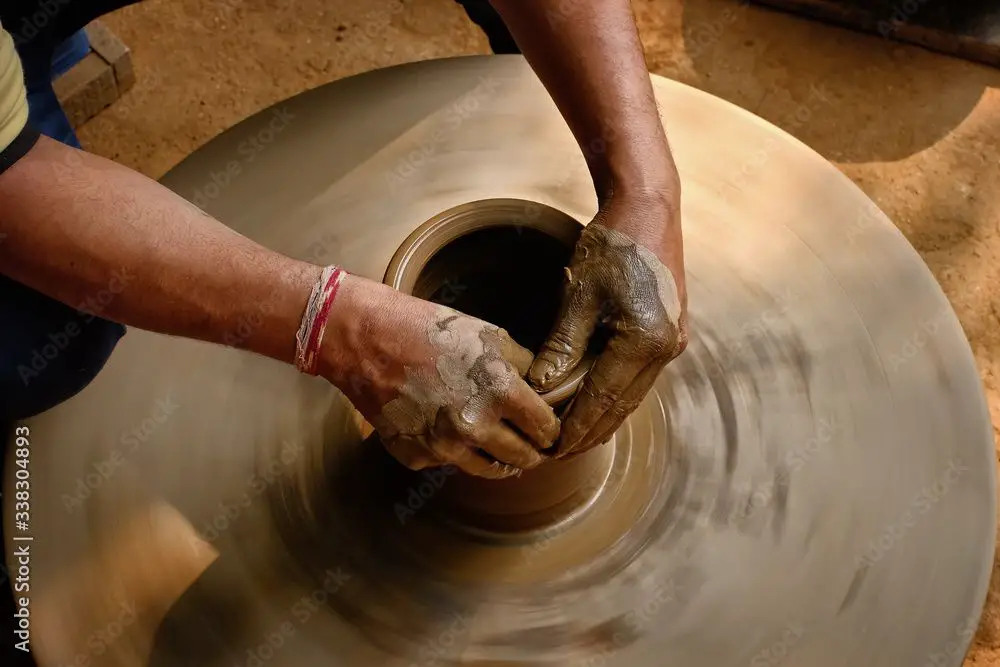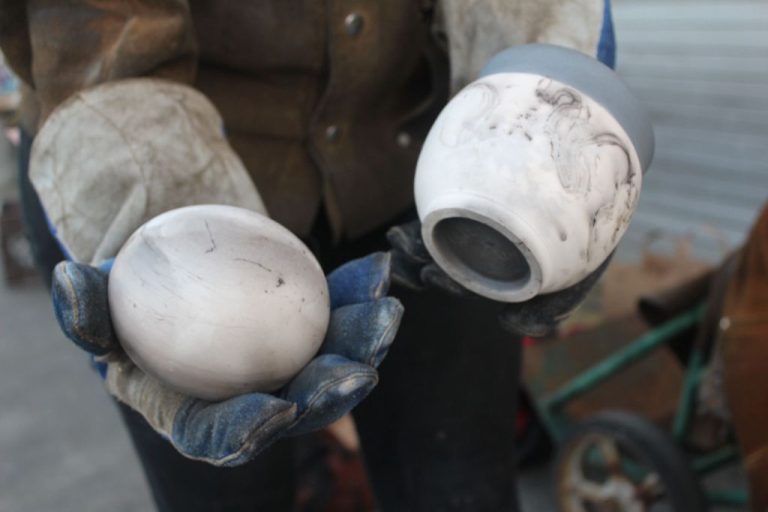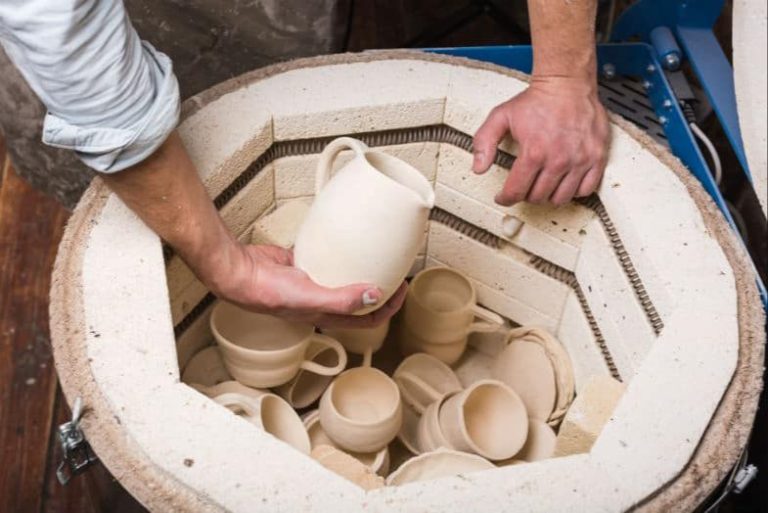What Are Indian Clay Pots Called?
Indian clay pots are called by various names depending on the region, language, and local tradition. They have been an essential part of Indian cuisine and culture for thousands of years. Clay pots are traditionally made by hand from natural clay and minerals, shaped into cooking vessels, and fired at high temperatures.
The use of clay pots for cooking can be traced back to the Indus Valley Civilization era between 3300–1300 BCE. Archaeological evidence shows that pottery was an advanced craft during this early civilization located in modern-day northwest India and Pakistan. Primitive clay vessels were likely used for cooking, storage, and transport.
Over the centuries, clay pottery evolved into a refined art form and essential cooking tool across the various regions of the Indian subcontinent. The porous nature of clay allows it to retain moisture and heat, making it excellent for simmering and braising foods slowly at lower temperatures. This results in intensified flavors and tender textures.
Regional Names
Clay pots have many different regional names throughout India. Here are some of the most common ones:
In North India, clay pots are commonly called matka or surahi. Matka refers to a round pot with a wide mouth, while surahi is a slender pot with a narrow neck and spout used for storing and serving water and other liquids (source).
In South India, clay pots go by names like manchatti, meen chatti, or simply chatti, especially in Kerala. They are traditionally used for cooking curries and stews (source).
In Maharashtra, clay pots are known as handi or matka. Handis are spherical pots used for cooking, while matkas are water storage vessels (source).
In West Bengal and Odisha, the term hunda is used for wide-mouthed clay pots. In Gujarat, clay pots are called kothari or gujari (source).
These varied regional names highlight the ubiquity and cultural significance of clay pots across India.
Manufacturing Process
Indian clay pots are primarily made by hand using traditional techniques that have been passed down for generations. The main steps in creating these pots are:
Gathering and Preparing the Clay – The potters dig local clay, often from river banks. They knead it thoroughly to remove impurities and add water to reach an ideal consistency.
Forming the Pots – Most pots are built using the coiling technique. Long coils of clay are layered and blended together to form the basic shape. The potter’s wheel is also sometimes used.

Decorating – Once dry, the pots are decorated using natural mineral pigments and tools to carve patterns and designs. Common techniques include painting, incising, stamping, and slipping.
Firing – The pots are fired in an open wood-burning kiln, reaching temperatures between 600-900°C. This hardens the clay and sets the colors.
Polishing – After firing, some pots are polished with smooth stones or wood to create a sheen.
The craftsmen use simple tools like wooden ribs, paddles, and their hands. Families often pass down pottery skills over generations. The production process preserves ancient methods while allowing for regional variations.
Source: https://ancientpottery.how/how-pueblo-pottery-is-made/
Clay Types
Different types of clay are used to make Indian pots and pans, depending on the properties needed for the final product. The main types used are:
Earthenware – Made from secondary clays like ball clay, fire clay or stoneware clay. It has high plasticity and absorbs water easily, making it easy to work with. However, it is porous and brittle with low mechanical strength. Earthenware fires at lower temperatures of around 1000–1200°C. Sources include the Gangetic plains and coastal regions. (Wheel & Clay, 2023)
Stoneware – Made from primary kaolin clays with high fusion temperatures of 1200–1300°C. It is less porous than earthenware, giving it more strength. It resists thermal shock, but is difficult to work with due to low plasticity. Sources include Rajasthan and Gujarat.
Porcelain – Made from kaolin clay, with a high fusion temperature of over 1300°C. It has very low porosity and high mechanical strength. However, it requires greater skill to work with. Sources include Kerala and Tamil Nadu.
Clays can also be combined to obtain desired properties. For example, ball clays are added to stoneware or porcelain to increase plasticity. The different geological sources and compositions result in clays with unique properties suited for various ceramic products.
Decoration
Indian clay pots featured intricate and beautiful decorations. The most common decoration techniques were painting, carving, and slip painting.
Painting was done with natural pigments like iron oxides for reds, manganese for browns and blacks, and plant materials for greens and yellows. According to How Pueblo Pottery is Made, the Pueblo Indians would apply paint directly to the clay surface using brushes made of yucca leaves.
Carved decorations were made by incising or impressing designs into the clay surface with tools. Common carved designs included geometric patterns, animals, and floral motifs. Carving was done when the clay was partially dry but still leatherhard. As shared in How to Make Anasazi Pottery, the Anasazi potters used pointed sticks for carved decorations.
Slip painting involved covering the pottery surface with a thin layer of liquid clay called slip before firing. The slip provided a smooth surface for painting. According to How Pueblo Pottery is Made, slip paints ranged from white to black, red, and yellow.
Usage
Clay pots have been used for a variety of purposes in Indian households for centuries. Some of the common uses include:
Food Storage: Clay pots are excellent for storing dry goods like grains, flour, spices, and lentils. The porous nature of clay allows air circulation while the thick walls prevent insects and pests from getting in. Storing food in clay pots helps preserve freshness and aroma.
Cooking: Indian clay pots or ‘handis’ are ideal for slow cooking dishes like dals, curries, rice dishes etc. The pores allow steam to escape preventing the food from boiling over. Cooking in clay pots is known to enhance flavors and nutrition. Dishes like biryani taste exceptionally good when cooked in a handi.
Water Cooling: During summers, storing drinking water in clay pots helps in natural evaporation which cools the water inside without using electricity. The small pores help the water ‘breathe’ while keeping it hygienic.
Milk Storage: Milk stored in clay pots stays fresh and cool for longer duration. The porous clay regulates temperature thereby preventing spoilage.
Traditionally, Indian women spent a lot of time in the kitchen and clay pots were an indispensable part of their cooking process. Today, clay pots are still used extensively in villages. Even in urban kitchens, clay pots find a place in cooking traditional cuisines.
Cultural Significance
Indian clay pots, known as matkas in Hindi and surahis in Urdu, hold a significant place in Indian traditions and culture. Here are some of the ways these humble clay vessels are significant:
Matkas play an important role in many Indian rituals and spiritual practices. Keeping water in a matka is considered auspicious in Hinduism, as the porous clay is believed to purify the water. Matkas are used to store holy water from rivers during rituals like Kumbh Mela. Brides often arrive at weddings carrying a matka filled with water, symbolizing prosperity.
Clay pots are intrinsically tied to India’s rich history. Ancient civilizations of the Indus Valley crafted beautiful pottery and terracotta figurines. Even today, matkas and surahis are handmade by potters using traditional techniques like wheel throwing and firing in kilns, preserving an ancient artform.
Gifting matkas is common during festivals like Diwali, as they make useful, eco-friendly and culturally significant gifts. Keeping a matka is said to connect people to the earth’s energy. Due to their porous nature, food and water stored in matkas is believed to retain vital nutrients and minerals.
Matkas thus provide a sustainable and holistic approach to cooking, hydration and storage that is deeply rooted in Indian philosophy and way of life. Their continued use in modern times is a testament to the rich history and cultural traditions around simple clay pots.
Modern Applications
Clay pots have seen a resurgence in modern interior design and cooking due to their sustainability, natural material, and artisanal heritage. Many restaurants feature clay pot dishes as a nod to ancient cooking traditions. Clay pots are also popular in home decor, adding an earthy, organic element to modern interiors. Companies like Clay Craft have revived the art of handmade Indian clay pottery using natural materials and traditional techniques. Their clay pots are free of lead and cadmium, meeting international safety standards.
Advances in clay pot technology have enabled new applications as well. Terracotta pots with waterproof glazes can be used for indoor plants. Pots fitted with drainage systems and filters allow for self-watering planters. Clay pots also work well for brewing kombucha at home due to the natural porosity. With innovations in clay pottery and interest in sustainability, these ancient vessels are finding renewed purpose in the modern world.
Notable Pottery Centers
India has a long and rich history of pottery making, with certain regions gaining renown for their distinctive styles and techniques. Some of the most notable pottery centers in India include:
Khurja, Uttar Pradesh – Known for its fine quality terracotta pottery characterized by its beautiful blue glaze. Many artisans from families that have been practicing the craft for generations. Products include vases, lamps, figurines, and more. References: https://www.thebetterindia.com/287886/jaipur-blue-pottery-karnataka-metal-handicraft-india-traditions/
Jaipur, Rajasthan – Famous for a distinctive style of blue pottery that involves complicated coloring and glazing techniques. Known for its ornate floral and geometric motifs. References: https://www.aurapottery.com/blog/post/7-pottery-spots-in-india-that-you-must-visit
Bankura, West Bengal – Known for terracotta pottery distinguished by hand-molded figures of horses and elephants. Uses natural dyes and colors derived from plants for decoration. References: https://www.thebetterindia.com/287886/jaipur-blue-pottery-karnataka-metal-handicraft-india-traditions/
Future Outlook
The future of the Indian ceramic and pottery industry looks promising according to some sources. There are several key trends and innovations shaping the outlook:
Customization is on the rise, with consumers demanding more personalized and unique pottery products. Many potters are embracing this shift by offering customized shapes, sizes, colors, and designs.1
New innovative materials and surfaces are being introduced into pottery, such as metallic glazes, glow-in-the-dark effects, crackle finishes, matte surfaces, and more. These innovations allow for greater creativity and appeal.1
There is a revival occurring in traditional pottery styles and techniques, with many artisans bringing back regional styles. However, there are challenges due to lack of skilled labor and competition from modern materials.3
Overall, the industry is transitioning from small scale pottery to larger scale ceramic manufacturing. If innovations continue and demand rises, the future looks bright for Indian potters and ceramicists.




